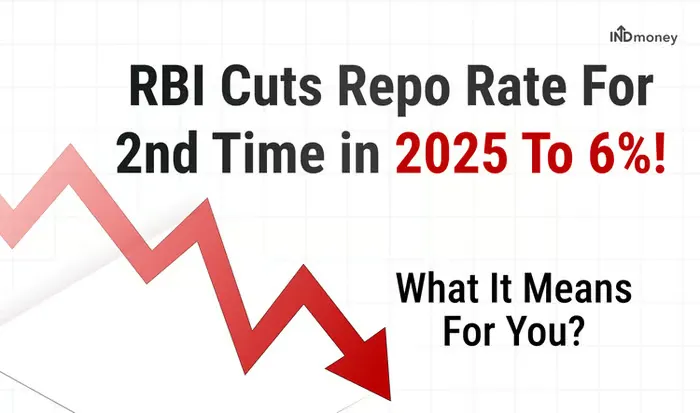RBI Repo Rate 2025 : The Reserve Bank of India (RBI), in its latest Monetary Policy Committee (MPC) meeting, decided to keep the repo rate unchanged. While this may not immediately benefit home loan borrowers, there is still a strong possibility of rate cuts in the coming months.
Over the past few months, the RBI has reduced the repo rate significantly. By June 2025, the central bank had lowered it by a total of 100 basis points (bps) – from 6.5% to 5.5%. This move has provided major relief to home loan borrowers, especially since most loans in India are on floating interest rates linked to the repo rate.
RBI Repo Rate 2025

Will There Be More Repo Rate Cuts Ahead?
Retail inflation plays a key role in deciding policy rates. In India, retail inflation has been steadily declining for the past 8 months and dropped to 2.1% in June 2025, the lowest in the last 12 months.
Experts believe that if this trend continues, the RBI may announce another cut in the coming months.
- V. K. Vijayakumar (Chief Investment Strategist, Geojit Investments Limited) says: “With good monsoon and healthy Kharif sowing, inflation is likely to remain under control, giving the MPC room for further rate cuts.”
- Raoul Kapoor (Co-CEO, Andromeda Sales and Distribution) adds: “The 100 bps reduction in the last three MPC meetings is not the end of this easing cycle. We expect more relief for borrowers in the near future.”
What Does the Market Indicate?
The 10-year Government Bond Yield, which was at 6.84% in January 2025, dropped to 6.16% by May. Currently, it is hovering around 6.3%, suggesting that the market does not expect sharp rate cuts in the immediate future.
However, the SBI research report projects that the RBI could reduce repo rates by up to 100 bps in FY 2025–26. With April and June 2025 already seeing a combined 75 bps reduction, there is still room for a 25 bps cut later this year.
- Sushil Bedarwal (CMD, Bedarwal Group) comments: “If macroeconomic conditions remain stable, the RBI may lower rates by another 25–50 bps before the end of this calendar year.”
All Eyes on the October Policy Meeting
The October 2025 MPC meeting is highly anticipated.
According to Amit Prakash Singh (CBO Urban Money & Co-Founder, Square Yards): “A rate cut just before the festive season could boost consumption, improve buyer sentiment, and provide a major push to the real estate sector.”
How Repo Rate Directly Impacts Your Home Loan EMI
Every change in the repo rate directly affects home loan EMIs. When the RBI cuts rates, banks also lower their lending rates, reducing the borrower’s monthly outgo.
Example: On a ₹30 lakh home loan, if the interest rate falls from 8% to 7.5%, the EMI reduces by about ₹900–1,000 per month. Over the full tenure, this can save lakhs of rupees.
This is why home loan borrowers closely track RBI policy announcements.
Impact on the Real Estate Sector
Lower repo rates not only benefit borrowers but also provide a strong boost to the real estate market. Reduced EMIs improve purchasing power, encouraging more people to buy homes. This, in turn, increases bookings for developers and restores investor confidence in the sector.
Every repo rate cut generally leads to positive momentum in property sales.
Golden Opportunity for First-Time Homebuyers
If you are planning to buy your first home, this could be the right time. Falling interest rates mean lower EMIs, making home ownership more affordable.
Additionally, several states provide subsidies and tax benefits to first-time buyers. If the RBI goes for another rate cut later this year, property purchases will become even cheaper. For new buyers, this is a golden chance to make a move.
What Should Home Loan Borrowers Do Now?
The benefit of RBI’s previous cuts is already being passed on by banks, but the extent depends on the type of loan you have.
1. Loans Linked to EBLR (Repo-Linked Loans)
- If your loan is linked to the External Benchmark Lending Rate (EBLR) – usually tied to the repo rate – you’ll see an immediate reduction.
- You can either lower your EMI or keep EMI unchanged and reduce the loan tenure.
- Experts recommend reducing tenure, as it results in much bigger long-term savings.
2. Loans Linked to MCLR, Base Rate, or BPLR
- As per the SBI report, around 35.9% of loans are still MCLR-linked.
- Since MCLR has a longer reset period, the benefit of lower rates comes with a delay.
- If your loan is still under MCLR, Base Rate, or BPLR, it’s better to switch to an EBLR-based loan for faster transmission of rate cuts.
Conclusion
Currently, the RBI has paused repo rate changes, but with falling inflation and stable economic conditions, further cuts are highly possible in the coming months. A festive season rate cut would directly benefit home loan borrowers by reducing EMIs and boosting real estate demand.
If your loan is still under MCLR or Base Rate, shift to an EBLR-linked loan. If you already have a repo-linked loan, choose to reduce tenure instead of EMI – this way you save lakhs in interest over the long run.